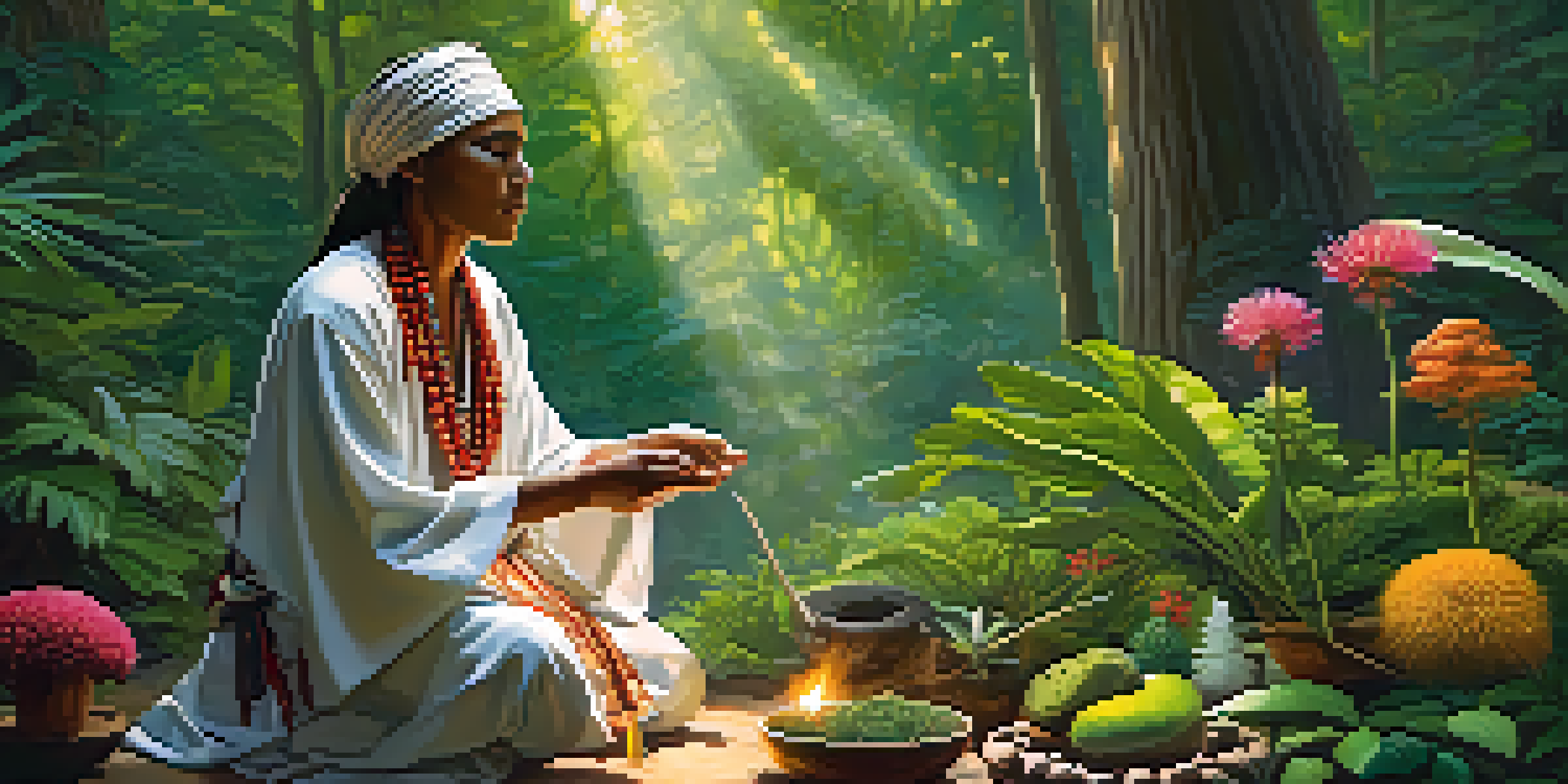Entheogens: A Path to Cultural Resilience in Indigenous Societies

Understanding Entheogens and Their Cultural Significance
Entheogens are substances, often derived from plants, that are used in spiritual contexts to induce altered states of consciousness. For many Indigenous societies, these substances play a crucial role in rituals and healing practices, serving as a bridge between the physical and spiritual worlds. By understanding the cultural significance of entheogens, we can appreciate their role in preserving traditional knowledge and practices.
The plants, the fungi, and the animals are not our resources; they are our relatives.
These substances have been utilized for centuries, often passed down through generations as sacred tools for connecting with nature and the divine. The rituals surrounding their use are deeply intertwined with the identity and values of Indigenous peoples. This connection fosters a sense of belonging and continuity in the face of external pressures and changes.
In a world that often overlooks Indigenous wisdom, recognizing the importance of entheogens can help us appreciate their role in cultural resilience. As societies evolve, these practices can serve as a reminder of the rich heritage and knowledge that Indigenous communities hold, making them vital for both cultural preservation and personal healing.
The Role of Entheogens in Healing and Spiritual Practices
Entheogens are frequently used in healing rituals, providing a means for individuals to confront personal traumas and societal issues. Many Indigenous cultures believe that these substances can facilitate a deep introspective journey, allowing participants to access insights that promote healing and well-being. This process not only benefits individuals but can also strengthen community ties as shared experiences foster empathy and understanding.

Moreover, the communal aspect of these rituals often reinforces social cohesion within Indigenous societies. When individuals come together to engage in these practices, they share their stories, struggles, and triumphs, creating a collective narrative of resilience. This communal healing can be a powerful antidote to the fragmentation caused by colonial histories and modern challenges.
Cultural Significance of Entheogens
Entheogens are vital in Indigenous rituals, serving as a bridge between the physical and spiritual worlds and preserving traditional knowledge.
Ultimately, the integration of entheogens in healing practices showcases the profound connection between spirituality and health in Indigenous cultures. By prioritizing these traditional methods, communities can reclaim their narratives and empower themselves, reinforcing their cultural identity in a rapidly changing world.
Cultural Resilience Through Traditional Knowledge Systems
Indigenous societies possess rich traditional knowledge systems that have been developed over centuries, often in tandem with the use of entheogens. This knowledge encompasses not only the specific plants and their uses but also the broader ecological wisdom about sustainable living and biodiversity. By incorporating entheogens into their practices, these communities uphold and pass down vital cultural knowledge that might otherwise be lost.
To understand Indigenous knowledge is to understand that it is not only about the past but also about the future of our planet.
The resilience of Indigenous cultures is intricately linked to their ability to adapt while maintaining their core values and beliefs. Entheogens provide a way for these societies to innovate within their traditions, allowing them to respond to contemporary challenges without sacrificing their identity. This adaptability is crucial for survival in a world that often marginalizes Indigenous perspectives.
In this way, entheogens serve as a vehicle for cultural continuity, enabling Indigenous peoples to navigate the complexities of modernity while staying rooted in their ancestral practices. By honoring these traditional knowledge systems, we can support the ongoing resilience of these communities and celebrate their contributions to global diversity.
Entheogens and the Reclamation of Indigenous Identity
The use of entheogens can play a significant role in the reclamation of Indigenous identity, particularly in post-colonial contexts. Many Indigenous peoples have faced the erasure of their cultural practices and beliefs due to colonization and assimilation policies. By re-engaging with entheogens, communities can reconnect with their spiritual roots and assert their cultural identity in a powerful way.
This reclamation process often involves a resurgence of traditional ceremonies and practices that incorporate entheogens, fostering a renewed sense of pride and belonging. As individuals participate in these rituals, they not only revive their cultural heritage but also reinforce their collective identity as a community. This shared experience can be particularly empowering for younger generations seeking to understand their roots.
Healing Through Shared Experiences
Healing rituals involving entheogens foster community ties and empathy, allowing individuals to confront personal and societal traumas collectively.
Moreover, reclaiming entheogenic practices can help counteract the negative narratives that have historically surrounded Indigenous cultures. By showcasing the positive aspects of these traditions, communities can challenge stereotypes and promote a more nuanced understanding of their identity. This journey of reclamation is essential for cultural resilience and can inspire other marginalized groups to explore their own heritage.
Entheogens as a Tool for Environmental Stewardship
In many Indigenous cultures, the use of entheogens is intimately linked to a deep respect for nature and the environment. These substances often originate from plants that are cultivated and harvested in sustainable ways, reflecting a broader philosophy of environmental stewardship. By honoring the relationship between humans and the natural world, Indigenous communities emphasize the importance of protecting their ecosystems.
Additionally, entheogenic practices can foster a heightened awareness of ecological issues, encouraging individuals to advocate for the preservation of their lands. When people engage with the spiritual aspects of these plants, they often develop a profound sense of responsibility toward the environment. This connection can motivate communities to take action against environmental degradation, thereby enhancing their resilience.
Ultimately, the integration of entheogens into environmental practices highlights the interconnectedness of culture, spirituality, and ecology. By promoting a holistic approach to environmental stewardship, Indigenous societies can inspire broader societal shifts toward sustainability and conservation, benefiting not only their communities but the planet as a whole.
Challenges and Misunderstandings Surrounding Entheogens
Despite their cultural significance, the use of entheogens is often met with skepticism and misunderstanding, particularly in Western contexts. Many people view these substances solely through the lens of recreational drug use, overlooking their profound spiritual and cultural roles. This misconception can lead to the appropriation of Indigenous practices without proper respect or understanding, further marginalizing these communities.
Additionally, legal barriers and stigma surrounding entheogens can hinder Indigenous peoples from practicing their traditions freely. Many Indigenous groups are advocating for the decriminalization of these substances to protect their right to cultural expression. By addressing these challenges, we can foster a more respectful dialogue about entheogens and their place in contemporary society.
Challenges of Cultural Appropriation
The growing interest in entheogens raises concerns about cultural appropriation, making it essential for Indigenous communities to control their practices.
Engaging in open conversations about entheogens and their cultural importance can help bridge understanding between Indigenous and non-Indigenous communities. Through education and awareness, we can work toward dismantling stereotypes and fostering a more inclusive perspective on these sacred substances.
The Future of Entheogenic Practices in Indigenous Communities
As societal interest in entheogens grows, Indigenous communities face both opportunities and challenges in preserving their practices. The increasing popularity of these substances in wellness and spiritual circles can provide a platform for Indigenous voices to be heard. However, it also raises concerns about cultural appropriation and the commodification of sacred practices.
Moving forward, it's essential for Indigenous communities to retain control over their entheogenic traditions and ensure they are practiced respectfully. This can involve educating outsiders about the cultural significance of these substances and advocating for the rights of Indigenous peoples to maintain their spiritual practices without interference. Collaboration between Indigenous and non-Indigenous communities can also foster mutual respect and understanding.

Ultimately, the future of entheogenic practices in Indigenous societies will depend on a balance between cultural preservation and adaptation. By embracing both their heritage and the contemporary world, Indigenous communities can cultivate resilience and ensure that their practices continue to thrive for generations to come.
Conclusion: Celebrating the Resilience of Indigenous Cultures
Entheogens serve as a vital thread in the tapestry of Indigenous cultures, weaving together threads of spirituality, healing, and resilience. As we come to understand their significance, we can appreciate the profound ways in which these substances contribute to cultural identity and continuity. Celebrating this resilience means honoring the wisdom of Indigenous communities and supporting their rights to practice their traditions.
By fostering dialogue and collaboration, we can work towards a deeper understanding of entheogenic practices and their role in addressing contemporary challenges. This collaborative approach is essential in ensuring that Indigenous voices are heard and respected in discussions surrounding entheogens and cultural resilience.
In recognizing the importance of entheogens in Indigenous societies, we not only celebrate their cultural heritage but also contribute to a broader narrative of resilience and empowerment. Together, we can honor these traditions, ensuring that they remain alive and relevant in our rapidly changing world.